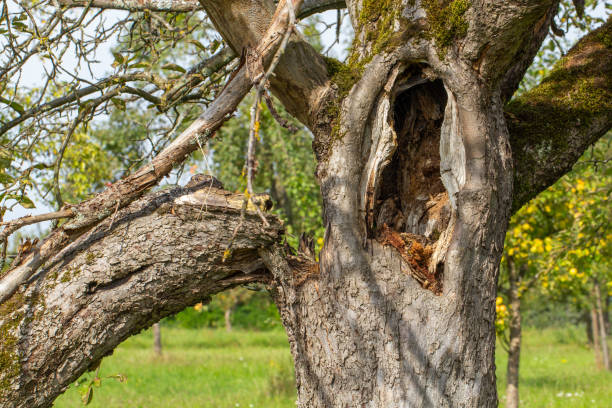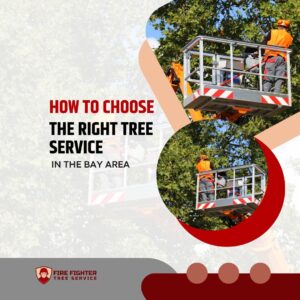Trees have many benefits, and parting with one can be hard. But some signs show tree removal is the only or the best option. The tree could be leaning dangerously over your property, infested by pests, decayed, or shedding significant leaves and twigs.
While most of these signs are obvious, others need an arborist assessment. For example, dying, infected, and invasive trees are not easy to tell whether they need removal or other remedies. As tree specialists, we have curated a guide on the tell signs a tree needs removal.
1. Extreme Infestation by Uncontrollable Pests
The emerald ash borer is one of the most destructive pests that we have dealt with in the Bay Area. The pests affect ash trees and can spread fast to other vegetation in the ecosystem. So, removal can help control the spread of these pests.
You can identify an infested tree if it has:
- Rounded or D-shaped exit holes
- S-shaped or zigzag tunnels in the wood
- Larvae’ presence on the tree
- Inhibited growth
- Clusters of eggs
- Signs of leaf damage or defoliation
Although most pests are controllable if detected and treated early, some cause severe and irreparable damage. You can consult our arborists to assess the extent of infestation and appropriate intervention measures.
2. Infection by a Disease that Compromises Integrity

According to the Mississippi Forestry Commission, diseases cause more than 45% of forest degradation. Fungal infections are the most destructive. The micro-organisms cause decay to the plant, making them weak. In California, sudden oak death and wilt are the most common infections.
Although most diseases are controllable, some will send your trees to the grave. Some tree species, like sycamore, dogwood, maple, hickory, walnut, birch, oak, and ash, are prone to diseases. So, you should keep a close eye on them.
3. Leaning Precariously over Buildings or Utility Lines
It’s probably the easiest way to know that a tree needs removal. Leaning trees pose risks to property and people. It could be a sign that the soil is too weak to hold the weight of the tree, or the roots are decaying. Tree falls are common during rainy and stormy weather, and consulting an arborist is crucial to prevent potential accidents and property damage.
DIY tree removal is not a good option for leaning trees. An expert should assess the best approach to remove the tree without damage to structures and utility lines. Weeping willows, cottonwoods, oaks, white spruces, and sugar maples are more susceptible to topples because of their shallow roots.
4. Root Decay
It is not easy to tell when a tree has decayed roots. However, some signs indicate the roots are decaying or have decayed. These include:
- Shedding leaves and twigs
- Dry branches
- Gradual leaning or tilting of the tree
- Discoloration or darkening of the bark
- Stunted growth
When roots die, they hinder the transportation of water and nutrients to the other parts of the plant. Consequently, the tree withers and sheds off leaves and fruits. Decay could be caused by pests, diseases, or tree maturity.
5. Problematic Shedder

Unlike trees like jacaranda, whose flower shedding means beauty to your surroundings, some could mean higher maintenance costs. A good example is a deciduous tree (like silver maple) that sheds a significant amount of leaves, requiring regular cleaning and disposal. Such trees could lead to clogged gutters and an unkempt appearance in your yard.
6. The Tree is Invasive
When a tree dominates other vegetation, it could be a sign the tree needs removal. Some species inhibit the growth of other plants. If the tree smothers other plants underneath it, it could lead to soil erosion due to a lack of soil cover.
Some of the invasive tree species in California are yellow star-thistle, giant reed, hottentot-fig, salt cedar, and scotch broom. It is possible to control the growth of these trees at the initial stages, but once seeds are dispersed, managing the tree species becomes more challenging.
7. Significant Storm Damage
Strong winds and rains uproot or damage trees, causing blockage to infrastructural facilities. The trees could also topple over buildings or utility lines, posing risks to property and lives.
After damage, you should move to a safe place and get in touch with emergency tree service providers. The experts will analyze the tree and recommend remedies to restore or remove the tree.
8. Bad Tree Crotch
Trees with tight-angled V or Y-shaped crotches are prone to snapping because of the weak joint. During storms, the trees are a hazard to nearby structures.
An arborist can assess the strength of a crotch to determine whether only one trunk or the whole tree needs removal. Typically, U-shaped trunks have a stronger connection and can sustain the weight of the branches.
9. Hollow Trunk

After decay, a tree can develop a tunnel through the trunk. Although it is not an obvious reason for tree removal, there are ways you can assess the extent of the damage. First, you can use a rubber mallet and tap the trunk to know how far the hole runs.
Secondly, you can observe if animals, like squirrels and owls, have burrowed through the tree. Checking the position of the holes can help you know how far the hole runs. Despite all these tests, the surest way is to consult an arborist to determine whether the signs warrant tree removal.
10. Dead Branches
Do you keep collecting twigs from a tree? It could be a sign that the tree is dead or decaying and needs removal. Although pruning will suffice for most dead branches, if you observe it in large branches, it could be hazardous. The branches can break and fall on structures during gusts of wind. So, you should hire an arborist to remove the tree if it poses such risks.
Conclusion
Most signs of a tree that needs removal are pretty easy to observe. However, others, like hollow trunks and root decay, require the services of an arborist to identify. Firefighter Tree Services is your go-to company when you need to remove a tree. We have the necessary tools and equipment. Our experts are also trained in handling even hazardous trees while observing safety protocols.






